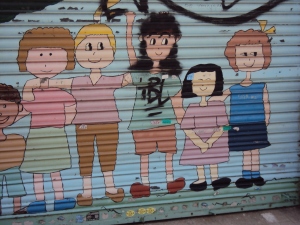Today, I drove to Oakland. On an overpass, across the highway, graffiti was sprawled across the cement. “Resist authority,” it said.
People in the suburbs don’t understand graffiti, but it’s been around for centuries—since Egyptian, Greece, and Roman times. Graffiti is a word or a picture that is scribbled, scratched, or painted, usually illegally, in a public place. Most often, the words express social or political views that defy authority or criticize the status quo. These words are powerful expressions; they often infuriate conservatives into passions of criticism and revulsion.

In 1964 in his song “Sounds of Silence,” Paul Simon wrote, “’The words of the prophets are written on the subway walls and tenement halls.’”
I think Simon was telling society to pay attention. We shouldn’t ignore graffiti; it foreshadows the protests of people who exert great effort to be heard. Energy is pent up behind graffiti’s words, and until that power is spent, it continues to build until it can no longer be contained in the paint on a wall, across a bridge, or around a garbage can. It represents the howl of people who don’t have a legitimized voice.
I listen to graffit. I want to sit down with the graffiti artists to hear their whole story, not just the few words that are sprayed on a wall. Why? Because graffiti artists, although not formally voted into office, are the true representatives of their community. They empathize with the story of their neighbors, and they have the courage to paint the pain of their friends over the arch of a highway. They have nerve. Audacity. In another word, courage.
Whenever I want to feel more understood and relevant, I tell my stories to somebody. I cry that my mother died a few days before Christmas and that Christmas will never be the same again. I talk about the ache from a break-up that has lasted for twenty years. And I repeat my worries about money and love and job security and children and my dead aunt over and over again, until one day, I have talked enough, and I stop crying.
Every community consists of staircases. In San Francisco, on Filbert Street, over two hundred stairs climb the hill to Coit Tower. In Berkeley, 125 Oakridge steps ascend to a stunning view of San Francisco Bay and the City. In Oakland, the Grand Lake and Trestle Glen neighborhood staircases guide residents away from the sidewalks among the blooms of spring and summer.
I’ve been climbing the staircases of these cities for years now. I started right after I underwent chemotherapy. I don’t mean to stir up any sympathy; I just want to demonstrate that I had a good reason for not being able to climb very far or very fast in the beginning. I’d stare up at the wild ascent from the bottom like I was a finless salmon at the foot of a river. The incline was daunting, and I panicked that I would never feel the heady rush of reaching the top. I was afraid of being doomed to crawl back and forth on the first few stairs, feeling weak and powerless, without hope or optimism.
Then one day, I climbed past the first flight of stairs. I rested on the landing like a panting dog, my torso leaning against the railing for support. I scrambled up the second flight and sloughed across the next landing, gripping the rail with clenched claws, too winded to speak.
I scaled and mounted the steps like they were enemies. I heaved and sighed, trudged and tripped. I counted and lost count. I ascended the steps while dots danced across my eyes and pins jabbed the center of my chest. Then, when I was too weary to go any farther, a stranger grabbed me around the waist and pushed me up. We climbed like one unit, in a slow march for a common purpose. And I found the top of the stairs, my head in a fog, deficient of breath and oxygen, with a new friend beside me.
Not every stair can be climbed alone if you don’t have shoes, can’t afford a cane, or just don’t have the stamina.

This is why I want to listen to the graffiti. Graffiti is the story of people who want to climb the stairs, but who are trapped at the bottom. I want to listen to their stories and walk a few stairs with them until they can see their way to the top. Along the way, I will make new friends. I could use more. While I listen to their stories and help them mount the stairs, I realize that I’ll be climbing higher, too.

